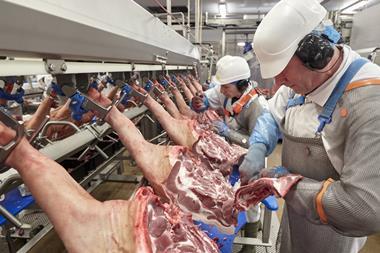Less contraction in national herd than farmers claimed
Supply picture looks resilient
Further doubt is cast on predictions of a looming shortage of home produced pork by the results of an official pig census showing much less contraction in the national herd than has been claimed by farmers.
Production will clearly fall again this year, but there are already hints of the decline in breeding stock numbers becoming shallower than in the first half of 1999.
Estimates by MAFF based on its latest survey of pig farms in England show the national breeding herd 5% smaller than in late 1998. This is less than half the 12% annual rate of decline indicated by the more comprehensive UK census in June.
Moreover, the latest figures show a more modest contraction, 3.3%, in the herd of "gilts in pig", young stock being used for breeding for the first time.
And the number of "maiden gilts" expected to be used for breeding appears to have stopped falling.
MAFF statisticians and MLC economists warn against taking these figures completely at face value. The survey was carried out at the beginning of November, a month earlier than usual, and the sample was relatively small.
Some slowdown in the rate of herd contraction triggered by the 1998 market collapse was to be expected after prices staged a partial recovery in the first half of last year.
This recovery petered out in the summer, and separate figures from MAFF showed a sharp increase in sow culling during November and December.
Nevertheless, the survey results contrast starkly against claims by producers' leaders who were warning in mid 1999 the national herd would shrink a third in the second half unless retailers, processors and the government helped protect farmers against imports.
{{MEAT }}
Close menu
- Home
- Retail & Wholesale
-
Products & Suppliers
- Back to parent navigation item
- Products & Suppliers
-
Product Categories:
- Back to parent navigation item
- Product Categories:
- Alcoholic drinks
- Bakery
- Cereals & breakfast
- Cheese
- Chicken & poultry
- Chocolate
- Confectionery
- Crisps, nuts & snacks
- Dairy
- Fish
- Fresh produce
- Frozen
- Household
- Meat
- Own Label
- Sauces & condiments
- Seasonal
- Soft drinks
- Vaping
- Vegan & plant-based
- World foods
- Suppliers
- People
- Reports & Data
-
Topics A-Z
- Back to parent navigation item
- Topics A-Z
-
Popular topics:
- Back to parent navigation item
- Popular topics:
- Cost of living crisis
- Crime
- Deposit Return Schemes
- Finance
- Government & Regulation
- Health
- Inflation
- Loyalty
- Marketing
- Mergers & Acquisitions
- New Product Development
- Sourcing
- Supply chain
- Sustainability & environment
- Technology
- Ultra Processed Foods
- Vaping
- A-Z all topics
- Content by type:
- Events
- Subscribe now
Sign in to comment on this article
Not logged in before? Register for FREE guest access today.
You will be able to:
- Read more stories
- Receive daily newsletters
- Comment on stories
Advert
















No comments yet